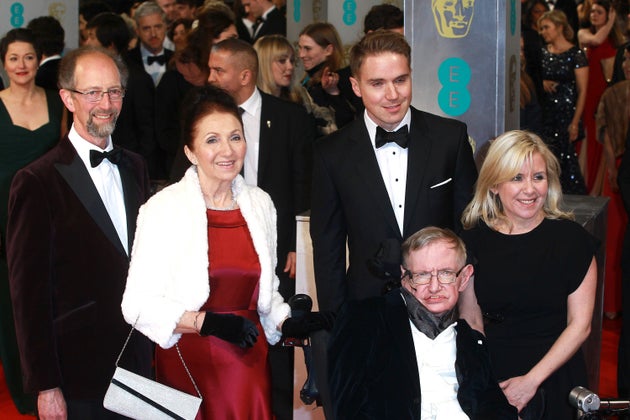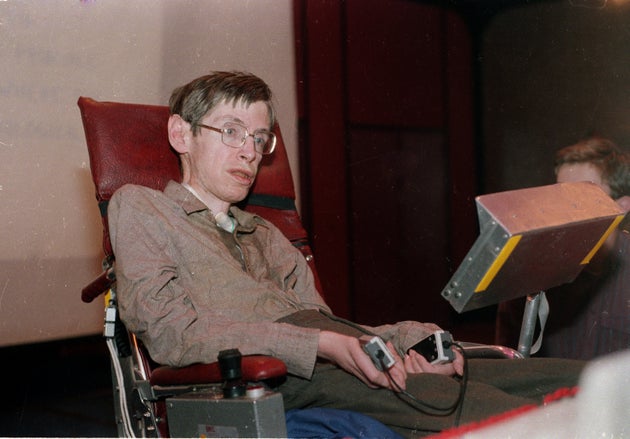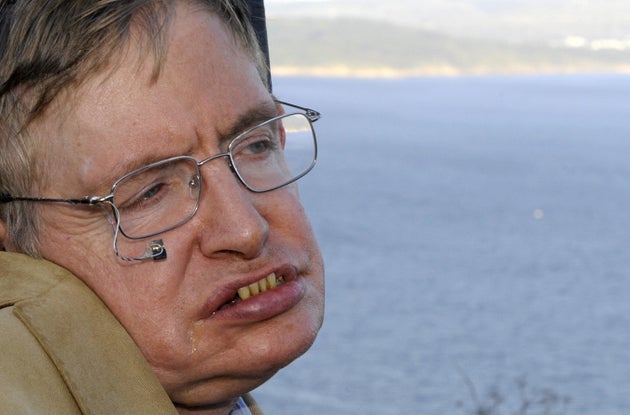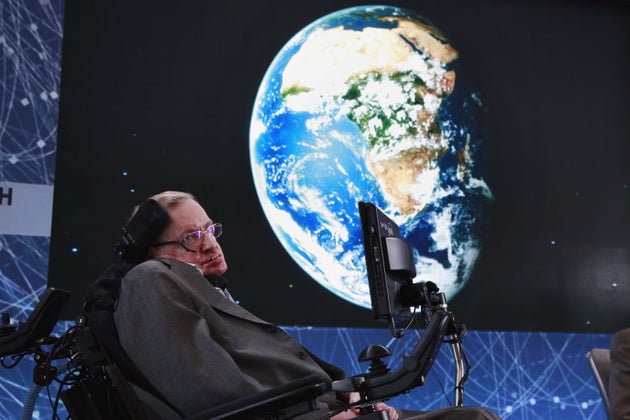Sad News :- Iconic Physicist Stephen Hawking Dies At 76
Stephen Hawking died Wednesday after complications due to amyotrophic lateral sclerosis, a progressive neurodegenerative disease. He was 76.
The world-renowned theoretical physicist and cosmologist was best known for his work on black holes. Hawking theorized that, contrary to the prevailing scientific belief that black holes were inescapable for all forms of matter and energy, they actually emitted a form of radiation ― now known as Hawking radiation. He also played a key role in the mathematical effort to unify Einstein’s general theory of relativity with the emergent field of quantum physics.
Hawking used his position as one of the world’s most famous scientists as a platform to discuss a wide range of issues, from the existence of extraterrestrial life to the nature of philosophy. He skyrocketed to public prominence in 1988, when he published his first general-audience book, A Brief History of Time: From the Big Bang to Black Holes. The cosmology treatise has sold approximately 10 million copies worldwide, making it one of the best-selling science books of all time.
In 1963, when he was just 21 years old, Hawking was famously diagnosed with the debilitating motor neuron disease amyotrophic lateral sclerosis. Though 80 percent of those with ALS die within five years of diagnosis, and Hawking’s own doctors gave him roughly two years to live, he survived for decades, perhaps longer than any other patient with the disease in medical history. Hawking used a wheelchair to move around and a sophisticated computer system to speak for much of his time as a public figure.
The physicist’s inspiring ― and turbulent ― personal story was dramatized in the 2014 movie “The Theory of Everything,” which was based on a memoir by Hawking’s first wife, Jane Wilde. Actor Eddie Redmayne’s portrayal of Hawking in the film won him an Oscar for best actor.
 FRED DUVAL/FILMMAGIC VIA GETTY IMAGESStephen Hawking, Jane Wilde Hawking and family attend the British Academy Film Awards at The Royal Opera House on Feb. 8, 2015 in London.
FRED DUVAL/FILMMAGIC VIA GETTY IMAGESStephen Hawking, Jane Wilde Hawking and family attend the British Academy Film Awards at The Royal Opera House on Feb. 8, 2015 in London.
Hawking was born on Jan. 8, 1942 ― the 300th anniversary of Galileo’s death ― in Oxford, England, to Frank, a physician specializing in tropical disease, and Isobel, a medical secretary. He and his three younger siblings grew up mostly in the town of St. Albans, just north of London, in what has been described as a highly intellectually-engaged home.
At the St. Albans School, Hawking was an indifferent student, preferring to spend his time playing board games and tinkering with computers. But he nonetheless gained admittance to his father’s alma mater, University College at Oxford University, in 1959, at the age of 17.
Upon arriving at Oxford, Hawking toyed with the idea of studying either math or medicine before eventually settling on physics. His attitude toward academic work remained lackadaisical in college. He rarely attended lectures and has said that he spent only 1,000 hours on studies during his three years at Oxford, or just an hour a day.
Still, Hawking’s natural brilliance started to shine through as an undergraduate ― and he apparently felt that his tutors resented him for doing so well with so little work. When he submitted his final thesis, it was given a grade on the border between first-class honors and second-class honors, so Hawking had to face an oral exam that would determine his grade. Knowing his reputation, he reportedly told his examiners, “If you award me a First, I will go to Cambridge. If I receive a Second, I shall stay in Oxford, so I expect you will give me a First.”
He got a First. And, as promised, Hawking enrolled in graduate school at Trinity College, Cambridge in 1962, studying under the physicist Dennis Sciama and the famed astronomer Fred Hoyle. He became interested in the then-nascent study of black holes and singularities, the existence of which had been implied by Einstein’s general theory of relativity.  ASSOCIATED PRESSStephen Hawking in Chicago on Dec. 15, 1986. After Hawking lost his voice to pneumonia the prior year, computer scientist Walter Woltosz gave him a device that helped him vocalize words that he typed.
ASSOCIATED PRESSStephen Hawking in Chicago on Dec. 15, 1986. After Hawking lost his voice to pneumonia the prior year, computer scientist Walter Woltosz gave him a device that helped him vocalize words that he typed.
While studying at Cambridge, Hawking met Wilde, a fellow St. Albans native who was a student in modern languages at Westfield College in London at the time. Before the two started dating, Hawking collapsed while ice skating and couldn’t get up. His mother made him go to the doctor, who diagnosed him with ALS and estimated he had just over two years to live.
Years later, during a symposium at Cambridge on his 70th birthday, Hawking reflected on how much he struggled to stay motivated after his diagnosis. Why work so hard for a Ph.D. when you could be dead in two years?
However difficult life may seem, there is always something you can do, and succeed at. It matters that you don't just give up.Stephen Hawking, as he celebrated his 70th birthday
“Remember to look up at the stars and not down at your feet,” he said. “Try to make sense of what you see and about what makes the universe exist. Be curious. And however difficult life may seem, there is always something you can do, and succeed at. It matters that you don’t just give up.”
Hawking’s motor control deteriorated rapidly; he was soon walking to class on crutches. Yet the disease spurred him to deepen his relationship with Wilde quickly. They married in 1965.
After receiving his doctorate in cosmology, Hawking stayed at Cambridge to continue studying some of the most essential questions about the structure of the universe. In 1968, a year after Jane gave birth their eldest son, Roger, Hawking took a post at the Institute of Astronomy at Cambridge and began the mature phase of his academic career.
Over the next decade, Hawking published a string of groundbreaking papers on cosmology and theoretical physics that made him a celebrity in the scientific community.
He and English mathematician Roger Penrose wrote key papers in the late 1960s that related the Big Bang ― the event that created the universe ― and black holes, proving that both were the result of singularities in the fabric of space-time. In the early 1970s, Hawking and several other physicists co-wrote a proof of the hypothesis that all black holes can be described in terms of just their mass, angular momentum and electric charge.
It was in 1974 that Hawking proposed what is widely considered his most significant theory: that black holes can emit subatomic particles, now known as Hawking radiation. Prior to his paper, physicists had been sure that nothing could escape the crushing gravity of a black hole. The existence of Hawking radiation also implies that black holes can eventually wither away and die, something that had previously been inconceivable to scientists.
Soon after publishing his paper, Hawking, just 32 years old, was named a fellow of the prestigious Royal Society. He briefly taught at the California Institute of Technology before assuming the position of Lucasian Professor of Mathematics at Cambridge, a post dating back more than 400 years that was once held by Isaac Newton.
Though Hawking’s family life flourished during this time ― he and Jane Hawking went on to have two more children ― his health did not. He reluctantly started using a wheelchair in 1969, and by the mid-70s, he could no longer feed or clothe himself. MIGUEL RIOPA/GETTY IMAGESStephen Hawking on a trip to Cape Finisterre in Spain in 2008. The scientist married and divorced twice and had three children.
MIGUEL RIOPA/GETTY IMAGESStephen Hawking on a trip to Cape Finisterre in Spain in 2008. The scientist married and divorced twice and had three children.
In 1985, Hawking contracted pneumonia while on a trip to Switzerland. Doctors performed a tracheotomy that allowed him to breathe but rendered him unable to speak naturally. At first, he communicated using word cards, which was agonizingly slow. But in 1986, computer scientist Walter Woltosz gave him a device that would vocalize words he typed using a joystick. Hawking called this system, which has since been upgraded several times, “The Computer.” Its electronic voice was an integral part of the physicist’s public image.
Hawking first came up with the idea of writing a book about cosmology for a general audience in 1982. He said he conceived of the project to “earn money to pay [his] daughter’s school fees.” The first draft of A Brief History of Time was finished in 1984, but Hawking’s publisher felt it was too difficult for laypeople to understand, so he went back to work. The revision process became more complicated after Hawking lost his voice in 1985, but he managed to publish the book in 1988.
It was a massive hit: The book was on The New York Times’ best-seller list for three years and The Sunday Times’ U.K. best-seller list for nearly five. Its publication propelled Hawking to international fame that’s endured to this day. He published five additional general-audience books on science, plus one memoir and four children’s books. He also guest-starred on both “The Simpsons” and “Star Trek: The Next Generation.”  LUCAS JACKSON/REUTERSAt age 74, Stephen Hawking sits onstage during an announcement of the Breakthrough Starshot initiative with investor Yuri Milner in New York on April 12, 2016.
LUCAS JACKSON/REUTERSAt age 74, Stephen Hawking sits onstage during an announcement of the Breakthrough Starshot initiative with investor Yuri Milner in New York on April 12, 2016.
Stephen and Jane Hawking separated after several years of tension in 1990, which Jane said was exacerbated by her husband’s newfound “fame and fortune.” The physicist began a relationship with Elaine Mason, one of his nurses. After his divorce from Jane Hawking, he married Mason in 1995.
Hawking and his ex-wife did not speak for several years, but they started communicating again after he and Mason got divorced in 2007. Stephen and Jane Hawking later began living around the corner from one another in Cambridge.
In 2011, Hawking appeared on the Discovery Channel TV series “Curiosity,” in which he reflected on the origins of the universe and rejected the likelihood of both a God and an afterlife. (He once dismissed the latter as “a fairy story for people afraid of the dark.”) Only in confronting the finite nature of death, he said, do we appreciate the remarkable beauty of life in the present.
“There is probably no heaven, and no afterlife either,” Hawking said. “We have this one life to appreciate the grand design of the universe, and for that, I am extremely grateful.”
In addition to his two former wives, Hawking is survived by three children and three grandchildren.
Courtesy : huffingtonpost

